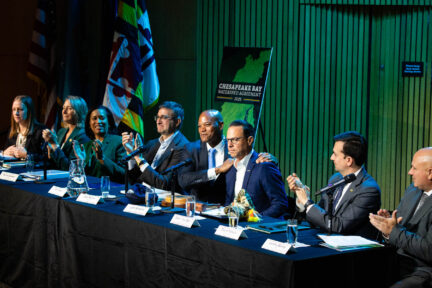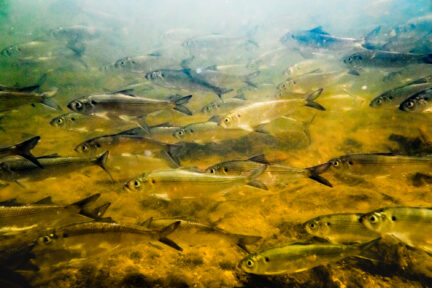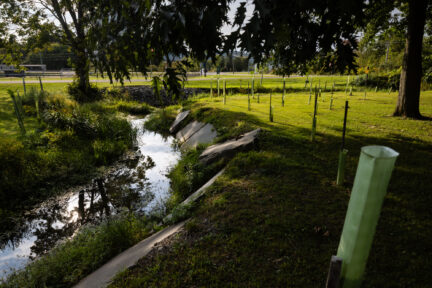Environmental literacy programming rebounds across Chesapeake watershed following COVID-19 pandemic
School districts across the Bay region continue to grow environmental education experiences for their students

Annapolis, MD—Today, the Chesapeake Bay Program announced renewed progress toward meeting two of the environmental education outcomes of the Chesapeake Bay Watershed Agreement, following a slight decline during the COVID-19 pandemic. This progress was identified through a 2024 survey of public school districts across the Chesapeake Bay region. Data from 302 school districts were included in the results, representing 74% of the K-12 population and 44% of all school districts across the Chesapeake Bay watershed.
The Environmental Literacy Indicator Tool (ELIT) voluntary survey uses responses from school districts to track progress toward environmental education goals. The Chesapeake Bay Program has distributed this survey every two years since 2015, with a one-year pause in data collection during the COVID-19 pandemic. It collects information on how prepared school districts are to support a comprehensive and systemic approach to environmental literacy for their students and tracks the availability of environmentally focused programming known as Meaningful Watershed Educational Experiences (MWEEs).
Environmental Literacy Planning
To measure progress toward the Chesapeake Bay Program’s Environmental Literacy Planning Outcome, school districts were asked to indicate whether they had environmental education programs, established program leaders, methods of training teachers and administrators, and other elements critical to a comprehensive and systemic approach to environmental education. In 2024:
- Nineteen percent of respondents self-identified as “well-prepared” to put a comprehensive and systemic approach to environmental literacy programming in place.
- Fifty-seven percent of respondents self-identified as “somewhat prepared” to put a comprehensive and systemic approach to environmental literacy programming in place.
- Twenty-five percent of respondents self-identified as “not prepared” to put a comprehensive and systemic approach to environmental literacy programming in place.
The percentage of school districts that were “well-prepared” in 2024 increased by 2% from 2022, rebounding almost to 2019 levels, while the proportion of “not prepared” districts decreased by 2%. Delaware, Maryland, Pennsylvania and Virginia all reported increases in the number of school districts who are “well-prepared” to put a comprehensive and systemic approach to environmental literacy programming in place.
Student MWEEs
To measure progress toward the Student Outcome, survey respondents described the availability of MWEEs in their district’s elementary, middle and high schools. In 2024:
- Thirty-one percent of reporting school districts at the elementary level noted providing system-wide MWEEs to at least one grade level, while 39% reported providing some MWEEs and 30% noted no MWEEs were available.
- Thirty-three percent of reporting school districts at the middle school level noted providing system-wide MWEEs to at least one grade level, while 41% reported providing some MWEEs and 26% noted no MWEEs were available.
- Thirty percent of reporting school districts at the high school level noted providing system-wide MWEEs in at least one required course, while 44% reported providing some MWEEs in at least one required course and 26% noted no MWEEs were available.
When comparing data from those school districts that reported in both 2022 and 2024, the percentage of elementary schools that increased their availability of system-wide MWEEs increased by 9.6%, the percentage of availability at middle schools grew by 9.7% and the percentage of available MWEEs offered at the high school level increased by 12.6%. Delaware, Maryland, Pennsylvania and Virginia all noted growth in offering system-wide MWEEs in at least two grade levels.
“Working in Richmond, Virginia, I have seen the way the James River becomes a place of curiosity and solace for students, and I know how connecting with a sense of place can drive one to act on issues in their community,” remarked Meredeth Dash, environmental education specialist with the Alliance for the Chesapeake Bay in Virginia. “Richmond Public Schools recently published an Environmental Literacy Plan, which for a community partner like me, provides a roadmap to follow so that my programs reach these students, and I can continue to support MWEEs across the school district.”
The full 2024 ELIT survey results can be found on the Chesapeake Bay Program website.
The Future of Environmental Literacy in the Chesapeake Bay Watershed Agreement
The Student and Environmental Literacy Planning outcomes measure the Chesapeake Bay Program’s goal to enable students in the region to graduate with the knowledge and skills needed to act responsibly to protect and restore their local watersheds. Updated versions of these outcomes will be included in the revised Chesapeake Bay Watershed Agreement, reaffirming the importance of environmental education in restoring the Bay and its watershed.
On July 1, 2025, members of the public are invited to weigh in on the draft of the revised Watershed Agreement, including new outcome language and targets for these two environmental education-based outcomes. Information on how to participate in the 60-day public feedback period, as well as the most up-to-date information on the revised Watershed Agreement, is available on the Chesapeake Bay Program website.
“Multidisciplinary environmental literacy instruction empowers students with the knowledge and skills needed to address present and emerging environmental challenges,” states Payton Hesse, environmental literacy specialist with the Office of Teaching and Learning Instructional Programs and Services with the Maryland Department of Education. “As we set ambitious targets for environmental literacy over the next fifteen years, we are both motivated to continue raising the bar and encouraged by our recent progress. In Maryland, we have seen an over 30% increase in systemic MWEEs offered in public school districts at the high school level since 2017. Building on our past success, our targets for 2040 underscore our commitment to ensuring all students have the opportunity to investigate and take informed action to address environmental challenges that impact their lives, communities and the watershed.”



